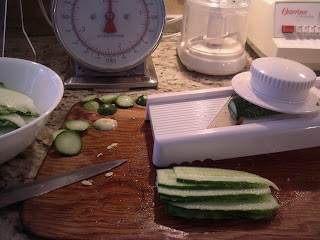There are many wonderful canning recipes out there for dill pickles and I have tried a number of them with great success. However, for this first batch of pickles this year I have decided to take the easier route and use Bernardin's pre-mixed dill pickle mix.
My pickling cucumbers have been coming in one or two at a time, so I've been collecting them over the last few weeks until I finally have enough for a couple of quarts or so of pickles. What you see in the picture above is about 4 pounds of cucumbers and as you'll see I ended up with 3 quarts of pickles.
The first step is prepare the cucumbers by first washing them, then trimming off both ends. It's essential to trim off the blossom end at least as the remains of the blossom contain an enzyme that will cause the pickles to go soft. Actually, the real first step is to prepare a water bath canner and few jars. I'll come back to the jars in a moment.
I decided to cut half the cucumbers into spears and use my mandoline on the other half to cut them lengthwise into sandwich slices.
The next step is to mix up the pickling brine and get it boiling.
This is simply 2 cups of water, 1 cup of white vinegar and 1/4 cup Bernardin's Dill Pickle Mix. Combine in a saucepan and bring to a boil while the water bath canner is heating.
The jars I'm choosing to use are what I suppose could be called "antique" as they have not been made for quite a while now. There are two types -- Crown and Gem -- and both were manufactured in Canada.
This is simply 2 cups of water, 1 cup of white vinegar and 1/4 cup Bernardin's Dill Pickle Mix. Combine in a saucepan and bring to a boil while the water bath canner is heating.
The jars I'm choosing to use are what I suppose could be called "antique" as they have not been made for quite a while now. There are two types -- Crown and Gem -- and both were manufactured in Canada.
The jar on the right is a Gem jar and the one on the left is a Crown. They are similar but their lids are different. Both are glass and require rubber rings to seal.
The Gem jar lids are closer to the modern snap lids in that the rim of the lid is higher than the center, the rubber ring fits around the underside edge of the lid (much like the sealing gum on the underside of a modern snap lid) and the rubber ring is placed in contact with the rim of the jar and held in position with a metal (in this case, zinc) band. Again, very similar to modern canning jars. By popular demand, since Gem jars are still being used (more so in Western Canada), Bernardin sells snap lids and rings specially to fit them as they are an odd size in between regular jars and wide-mouth jars.
Crown jars are slightly different in that the glass lid is more like a cap with an edge that sits over the rim of the jar so that the rim of the jar is actually inside the lid. The rubber ring is therefore placed around the outside of the jar rim and the glass lid is placed on top of it then secured with the zinc band.
The picture above shows the jars already packed with cucumbers ready for the brine to be added, but before that happened, I gilded the lily a little.
To each jar I added 2 peeled garlic cloves that I lightly bruised under a knife first by pressing down firmly with the heel of my hand just until the clove cracked slightly. I didn't want to smash the cloves, but just crack them a little so they would release their garlicky goodness into the brine.
I also added a pinch each of yellow mustard seed and black peppercorns as well as a sprig of fresh dill from my garden.
Then into the canner for 15 minutes once it was back up to a full boil.
The result: 3 quarts of garlic dill pickles. These need to age for 4-6 weeks for the proper flavour to develop and unfortunately 2 of my 3 jars did not seal, so once cool, I tightened the bands as much as possible and put them in the fridge to to age. I will treat them as refrigerator pickles as they are not shelf-stable. I am suspecting that I did not properly wipe off the rims before closing the lids as there is more to consider with these lids than the modern snap lids. I should have taken care to make sure that not only the rims of the glass lids were free of any spilt brine, but the surface of the rubber sealing rings as well. I do love the old-fashioned look of the pickles in these jars, but I will take care in future when using them to make sure all surfaces are residue-free so I don't lose any more jars to failed seals.








No comments:
Post a Comment